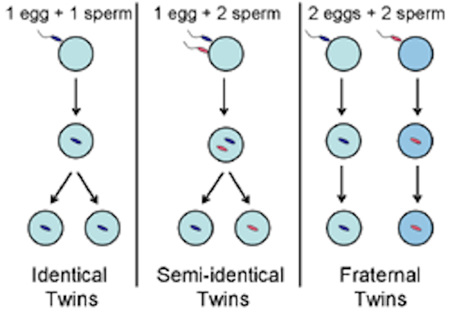
What is the difference between fraternal, identical, and semi-identical twins?
July 20, 2011

- Related Topics:
- Twins,
- Relatedness,
- Appearance,
- Pigmentation traits
A curious adult from Alberta, Canada asks:
“I have a couple of questions. First, what are semi-identical twins? How are they different from identical or fraternal twins? Do they look more fraternal or identical or are they somewhere in between? Second, how can Mary-Kate and Ashley Olsen look so similar but be fraternal twins? Could they perhaps be semi-identical twins?”
Great questions! First, everything I have read says that Mary-Kate and Ashley Olsen are fraternal twins.
Of course, the only way to be completely sure is through a genetic test. But there isn't any reason they wouldn't admit to being identical or semi-identical twins. So, I will give them the benefit of the doubt.
You probably already know the difference between identical and fraternal twins. Identical twins have 100% of their DNA the same while fraternal twins share only 50%. But what about semi-identical twins?
Well, they have 75% of their DNA the same. Here is how it all works.
Identical twins start out as a single fertilized egg. At some point very early in development, the fertilized egg splits into two. Each half grows into an identical twin.
They are identical because both siblings have the same set of DNA from mom and the same set of DNA from dad. Since both sets are the same they share 100% of their DNA.
Fraternal twins are really just siblings who share the same womb. Each starts out as a separate egg fertilized by a separate sperm. They don't share any more DNA than do any two siblings. Siblings normally have 50% of their DNA the same.
Semi-identical twins start from an egg that has been fertilized by two different sperms. Eggs fertilized with two sperms don't usually survive. But sometimes (well, at least once), they manage to split in a way that results in two people growing up that came from the same egg but different sperm.
So semi-identical twins share the same set of mom's DNA but have a different set of dad's DNA. From mom they are 50% the same and from dad they are 25% the same. Adding them together gives you 75% of the same DNA.
You might expect semi-identical to look more alike than fraternal twins. But we don’t really know for sure yet.
There's only been one confirmed case of a semi-identical twin. And, as you know some fraternal twins end up looking very similar and others very different. Just look at Mary-Kate and Ashley!

The Recipe for Looks
Has anyone ever asked if you and your friend are related? Do you ever get comments that you and some else look alike even though you are totally unrelated? Do you know someone that looks like a famous celebrity?
If so, you may be aware that people with different DNA can end up looking pretty similar. Even if they aren't related. How is this possible?
There are a bunch of reasons. First off, there aren't that many genes that account for looks. So the odds of someone sharing many of them aren't as unlikely as you might think.
For example, there is a gene called MC1R that accounts for most red hair. Some people have a red version and some people don't. You don't have to be a close relative to share red hair with someone!
Now do this with a few more genes and you have someone with the same hair and eye color, the same nose and eyebrows, etc. They share many of the same traits because they happen to share the same versions of certain genes.
Of course this is even more likely with relatives. Two sisters are more likely to share many of the same gene versions compared to two unrelated women.
Another opportunity for unrelated people to look alike arises when some physical similarities can result from different combinations of DNA. This is especially true for traits that have limited variations but are determined by multiple genes.
Take height as an example. Scientists suspect that over one hundred different genes contribute to height. Some genes have a big effect and others have a smaller one. And then there are some genes that have the same effect.
But there are a finite number of heights. This means that people with very different DNA can end up with the same height.
Many other traits act this way too. So people with unrelated DNA can have similar traits. And with twins we have another similarity, age.

Age and Looks
Think about how you looked when you were 5. Or 8 or 23. Not exactly the same, right?
Well, this can be a big part of why people can look similar or different. And this is why fraternal twins often look more similar to each other than do other siblings.
Two five year olds look more alike than a five and a ten year old. This is even true for a 30 year old and a 45 year old. Even when they share the same DNA. This may be one reason twins can look so similar even when they are fraternal.
The take home message here is that people can look a lot alike even when they don't have the exact same DNA. Part of the reason is that they have certain DNA in common. And another can be outside factors like age.

Author: Antonio Gomez
When this answer was published in 2011, Antonio was a Ph.D. candidate in the Department of Microbiology & Immunology, studying host genetics of salmonella infection in Karla Kirkegaard’s laboratory. Antonio wrote this answer while participating in the Stanford at The Tech program.
 Skip Navigation
Skip Navigation
